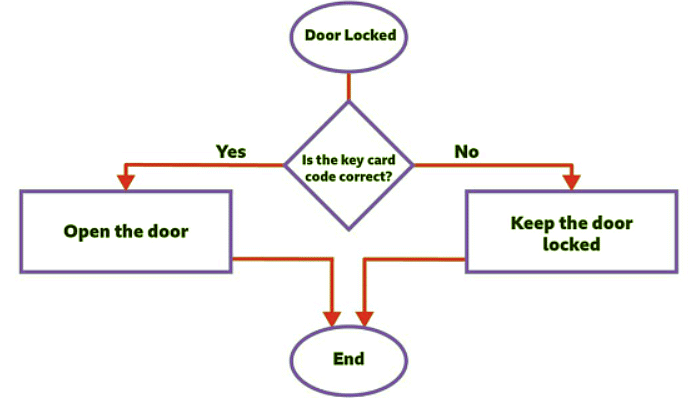Year 6 Exam > Year 6 Notes > Year 6 Computing > Algorithms
Algorithms | Year 6 Computing PDF Download
What is an algorithm?
- An algorithm is a sequence of instructions or rules designed to complete a task or solve a problem.
- Algorithms are used to plan and organize the steps required to accomplish various tasks.

Types of algorithms
Some examples of tasks where algorithms are used include:
- Navigating to unfamiliar locations using directions
- Developing new skills and techniques
- Learning to speak and write a new language
- Understanding the rules for sports and games
- Writing a program to control a computer-controlled device or system
- Organizing internet search results by order of importance
Understanding the Real-World Problem
- Imagine a scenario where we have a building situated in a bustling public street. The goal is to restrict access to only individuals employed in that specific building. This restriction is facilitated through a complex computerized system controlling the entrance doors.
- This system comprises:
- Automatic Doors with Locks: These doors operate independently and are secured with a locking mechanism.
- Key Card Reader: A device that reads the information stored on the key card.
- Key Card with Correct Code: Each authorized individual possesses a unique key card containing the necessary access code.
- Computer Processor: The core component of the system responsible for managing information and executing tasks.
- We need to develop a computer program to control the system and allow access only to those with the correct key card.
- Before writing the program, we must decompose the problem into smaller steps and create an algorithm.
Question for AlgorithmsTry yourself: What is the key component responsible for managing information and executing tasks in a computerized access control system?View Solution
Using a flowchart to organise the steps
An algorithm helps us determine the steps and their sequence for a task.
Let's use a flowchart diagram to organize our instructions:
- Start with the door locked.
- When someone inserts a key card into the door lock:
- The computer processor inside the lock checks if the key card has the correct code.
- If yes, flash the light green and unlock the door.
- If no, flash the light red and keep the door locked.

Write down these instructions as an algorithm to ensure correctness and sequence.
Use this algorithm to develop the computer program for the door lock system.
Identifying and Correcting Errors in Programs
- Understanding the Issue: When our computer programs do not function as intended, it is often due to errors known as bugs.
- Importance of Algorithms: Algorithms play a crucial role in programming as they provide a step-by-step guide for solving a problem.
- Example - The Door Problem: In a scenario where a door system failed to close after the first user, leading to security issues, we realize the importance of accurate algorithms.
- Algorithm Evaluation: To rectify such issues, we revisit the original algorithm to identify any mistakes in the sequence or steps we programmed.
- Reflecting on Expectations vs. Reality: By comparing what we intended the program to do versus what it actually does, we can pinpoint discrepancies and bugs.
- Example - Debugging in Action: For instance, in fixing the door system bug, we might realize that a specific step was incorrectly implemented, leading to the security flaw.
Understanding Algorithms in Computer Systems
- Algorithms are also utilized within computer programs and systems to make decisions and organize data.
- These algorithms are known as machine learning algorithms.
- Machine learning algorithms consist of rules that instruct the computer program on how to respond to various types of data.
- They can learn to predict outcomes or make decisions based on the data they receive.
- The performance of machine learning algorithms improves with more data.
How did it know I wanted one of those?
- These machine learning algorithms can assist a social media platform in selecting adverts based on your online activity.
- The algorithm applies its rules to your data, learning your preferences and interests.
- As a result, you will primarily see adverts related to your interests.
- Similarly, a search engine algorithm has hundreds of rules that organize the data it has collected about various websites. This organization helps determine the order in which search results are listed.
- The algorithm ensures that only the most popular and relevant websites appear at the top of the search results.
The document Algorithms | Year 6 Computing is a part of the Year 6 Course Year 6 Computing.
All you need of Year 6 at this link: Year 6
|
19 videos|26 docs|3 tests
|
Related Searches
















